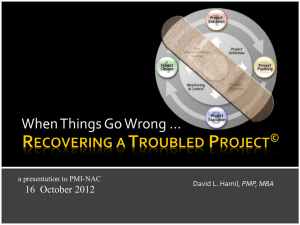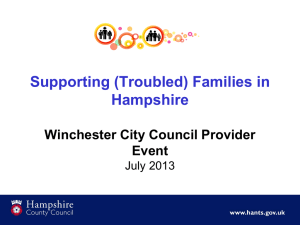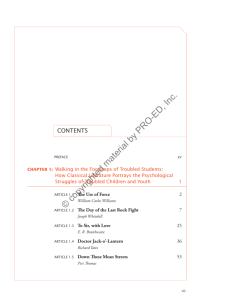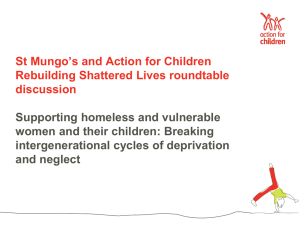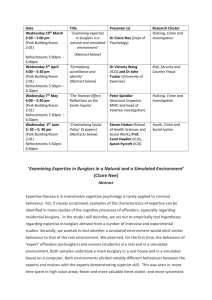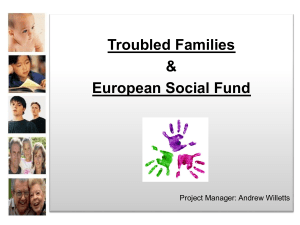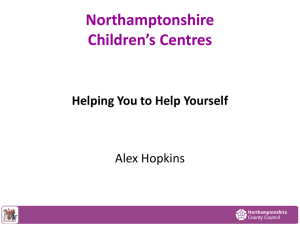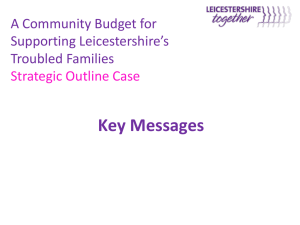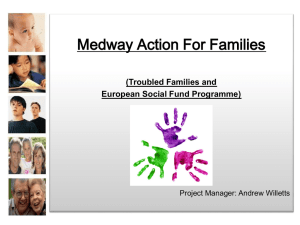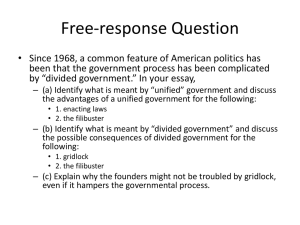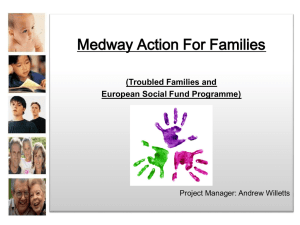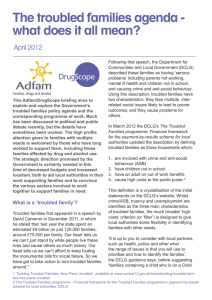342kb Powerpoint - Social Services Research Group
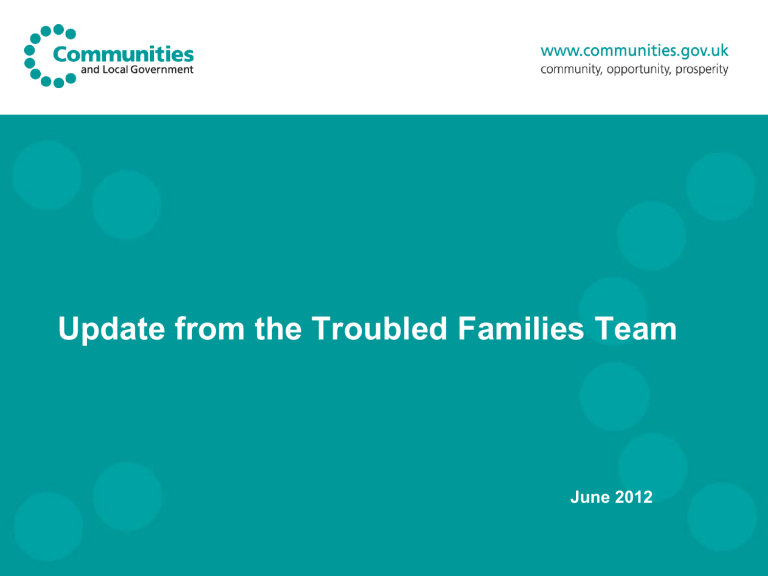
Update from the Troubled Families Team
June 2012
How did we get here?
•
December 2010: Prime Minister committed to turn around 120,000 of the most troubled families by
2015.
•
Summer 2011: The riots – Focus on troubled families ambition became more acute and PM committed to put “rocket boosters” under the programme.
•
November 2011: SoS for Communities appointed to lead the work at Cabinet level and new central, xdeptal Troubled Families Team established in DCLG, led by Louise Casey CB.
•
December 2011: Prime Minister announced £448m additional investment to put “rocket boosters” under the ambition, with investment from 6 departments.
•
March 2012: Financial Framework for the Troubled Families programme’s payment by results scheme for local authorities launched.
•
June 2012: All local authorities have signed-up to the programme and to start work with at least a third of their local total of troubled families in 2012/13
How is the Troubled Families Programme being delivered?
National Network of Troubled Families Coordinators in Every Upper-Tier Local Authority
Government Investment on Primarily a PbR Basis to Meet an Average of 40% Costs of
Services for 5-out-of-6 Troubled Families in each Local Authority
Investment and Prioritisation of Services and Resources by Local Authorities and a Range of Other Local Public Bodies
A number of Government-funded programmes targeted at supporting troubled families (inc.
+£200m European Social Fund Provision; and Multi-Systemic Therapy Pilots)
How are real troubled families being identified?
Scale: While most LAs know who some of their troubled families are, few have a complete list and most have struggled to access the necessary benefits info.
There will be 2 main ways in which local areas will identify their troubled families:
1.
Confirm Do known families fall within the 'troubled‘ definition?
2.
Identify the Wider Group Follow the 4-stage process outlined below:
Identify the families who are committing high levels of antisocial behaviour and/or youth crime
From this list, identify the families within children who are not attending school.
From this list, apply
‘local intelligence’ to ensure the ‘most troubled’ families are prioritised.
From this list, identify the families who are furthest away from work.
Families who meet 3-out-of-3 of the first three stages are automatically included.
Families who meet any 2 of the 1st 3 stages may be included - prioritised on local intelligence.
What does the identification process entail?
•
Youth Crime: Broad scope covering custody, fines, community sentences, reprimands, warnings, cautions and PNDs. Source: Police and YOTs (s.115, Crime and Disorder Act)
•
ASB : ASBO, ASB Injunction or ABC etc (or comparable measures or interventions). Source:
Community Safety Partnerships.
•
School: A permanent exclusion; 3+ fixed exclusions over the last 3 terms; in a PRU; not on the school roll; or had 15%+ unauthorised absences over the last 3 terms. Source: Unique Pupil Number data collected on a termly basis (s.17, Children Act 1989)
•
Work: An adult on DWP out of work benefits. Source: New agreement with DWP to share data with
LAs (without informed consent) for the sole purpose of identifying troubled families (s72, Welfare
Reform and Pensions Act 1999 currently and new legal gateway under the regulations of the Welfare
Reform Act 2012).
•
Local Discretion: Add families who meet any 2 of the first 3 criteria + a high cost cause for concern
(e.g. Child Protection Plan, frequent police call outs, adult crime, mental health problems, substance misuse). Source: Partners in health, police, probation and children’s services as appropriate.
What are the results against which we are paying?
Option 1:
•
The majority of the results payment will be released following achievement of the education + youth crime + anti-social behaviour measures.
•
The remaining (minority – £100) proportion of the funding will be released when a LA also achieves the ‘progress to work’ measure of enabling an adult in the family to ‘attach’ for either the Work Programme or ESF Provision. or
Option 2:
•
The whole results payment will be released if an adult in the family has moved into a job
(and is not on the ESF Provision or Work Programme to avoid double-paying).
Not the Totality of Success:
A much broader range of outcomes may be involved in ‘turning around’ around a family’s life and may be essential pre-conditions to achieving the results in the
Financial Framework. 6
Next Steps
•
Support LAs to identify and start work with c.33% of their troubled families in this financial year and the majority of their families in 2014/15.
•
First results claimed in January 2013, but only one deadline for claiming results overall (May 2015)
•
Building the national network of Troubled Families Coordinators (conference on
18 th September).
•
Developing plans for research and evaluation with local areas.
